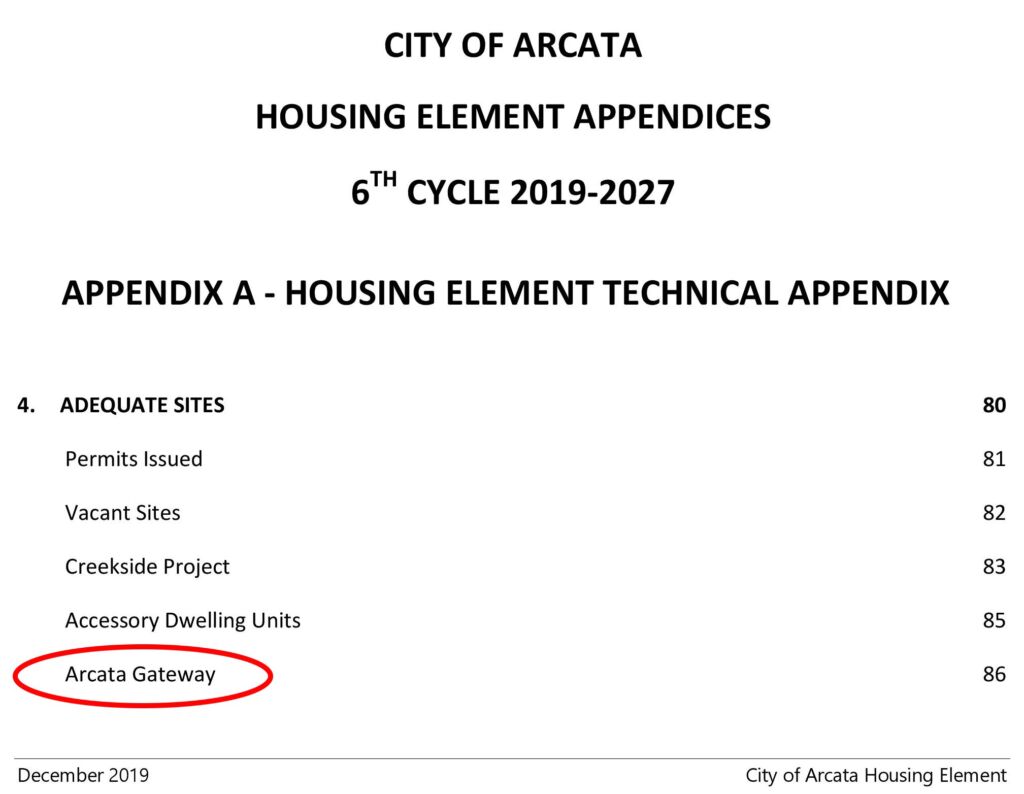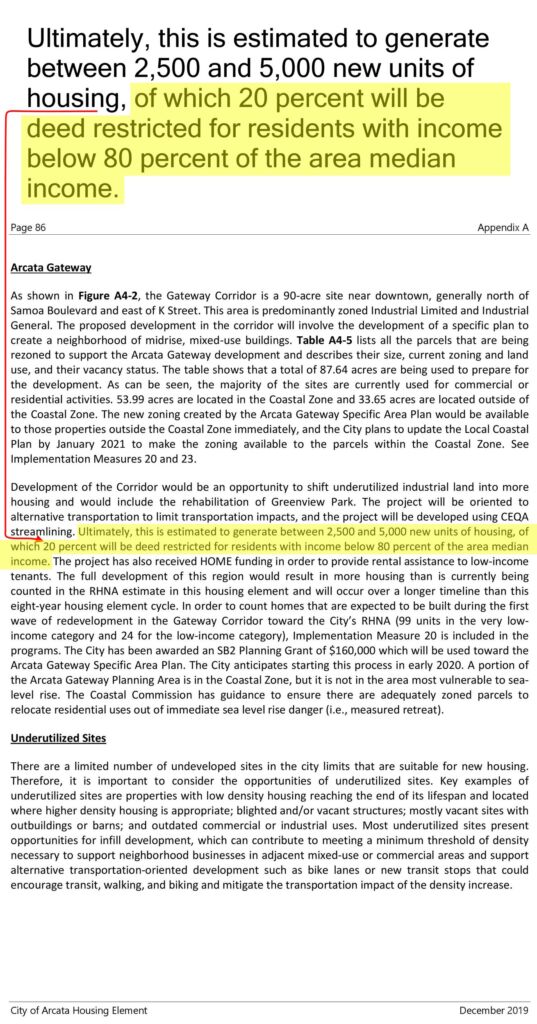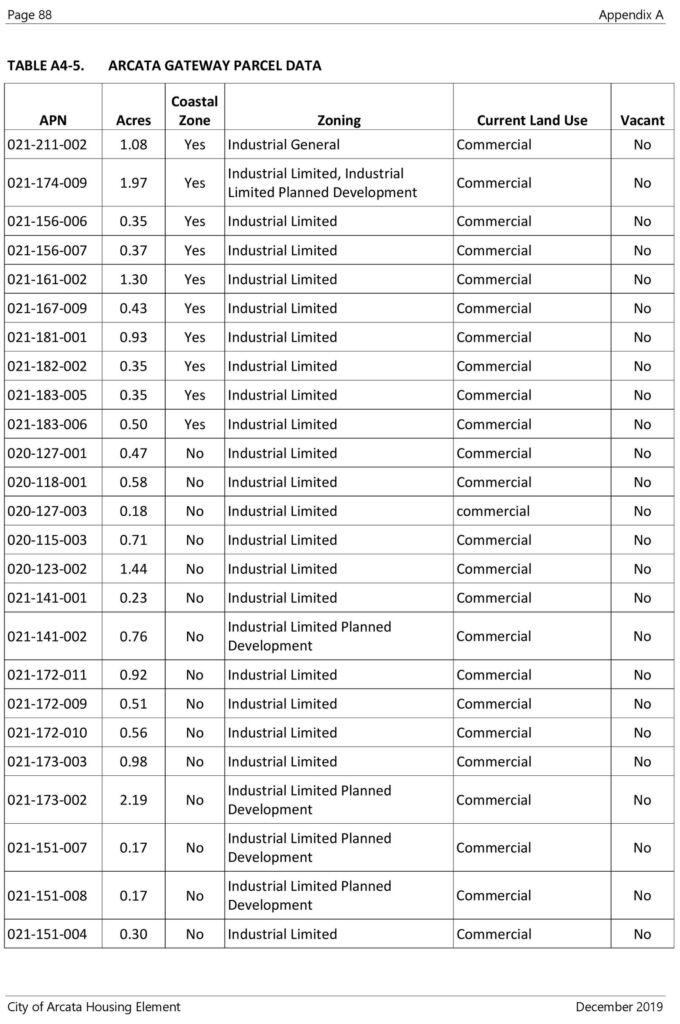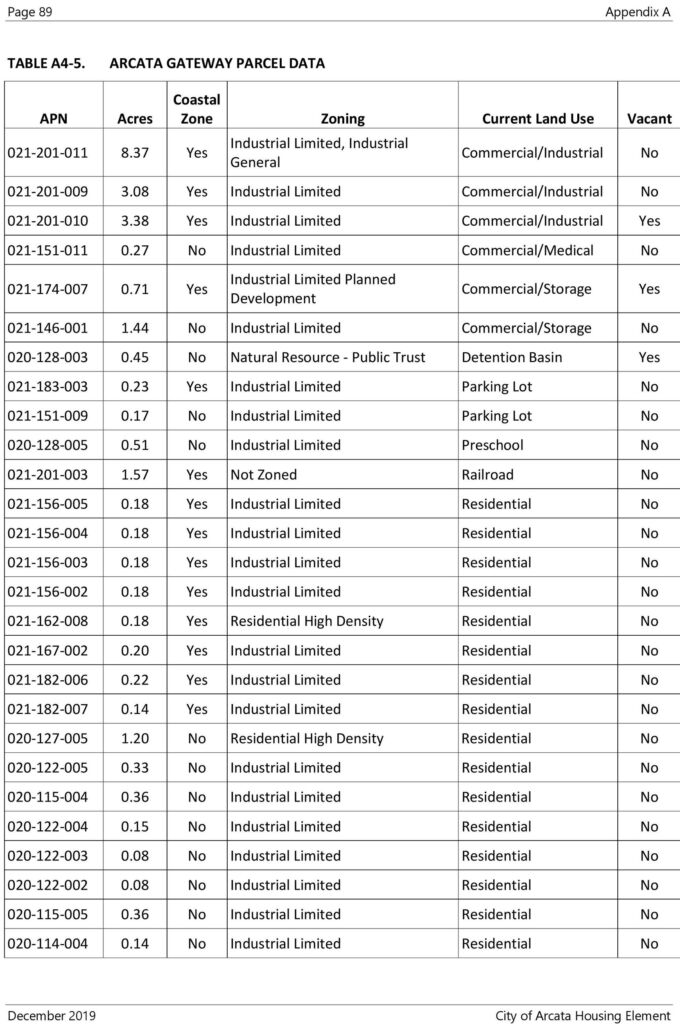The Housing Element is the document that describes the development of housing in Arcata.
The “City of Arcata Housing Element – 6th Cycle 2019-2027” was adopted by the City Council on December 2019, about four years ago, and was approved by the California Department of Housing and Community a month later.
The Housing Element is an Element (a chapter) in our General Plan. It is designed to be renewed and updated every eight years. This document will be an Element in the General Plan 2045, our new General Plan that is being worked on and is in draft form right now.
The Housing Element represents many hundreds of hours of input and work on the part of Staff, Planning Commission, City Council, local agencies, non-profit groups, developers, and the public. (Click here to go to a summary of the process and who was involved.)
Our community created this Housing Element.
The State certified it.
As a community, this is what we want.
The Housing Element tells us what the community wants.
The Housing Element is what the State of California approved for the development of housing in Arcata.
In the text of the Housing Element, the entire Gateway area development was designated as 20% affordable housing
“Affordable” in this use is defined as rent and utilities not exceeding 30% of the of the pre-tax earnings, based on a level that is 80% of the area mean income.
From the Housing Element, page 86, Appendix A, describing the Gateway area.
Ultimately, this is estimated to generate between 2,500 and 5,000 new units of housing, of which 20 percent will be deed restricted for residents with income below 80 percent of the area median income.
We can note that the Housing Element does not say “with an attempt to provide 20% deed restricted for 80% area median income households.” Or “with a goal of providing 20%….”
No, it says clearly and plainly: “…of which 20 percent will be deed restricted…” This is what the people wrote, and this is what the State approved.
The Gateway Area Plan now calls for just 6% affordable housing. What happened?
What happened? It’s a long story. Here’s a part of it.
With all of the changes, Arcata needs affordable housing more than ever. At the same time, the difficulties in achieving true affordable housing have grown.
Things have changed — locally, nationally, globally — since our Housing Element was created and adopted.
We have experienced the Covid pandemic, substantial general inflation, “supply chain” disruptions, spikes in building material prices, the war in Ukraine, and energy cost increases.
There’s also a increased demand for housing. People want to live in Arcata, now more than ever. We have the conversion of Humboldt State University to Cal Poly Humboldt, with the anticipation of a doubling of the student population from ~7,000 in 2019 and ~5,500 in 2021 to a projected ~12,000 in 2030, seven years from now. (See Cal Poly Humboldt – Expansion here on Arcata1.com.) There would also be an increase in Cal Poly faculty and staff of 700-1,000 employees.
There are complex interconnected issues at play. Factors include wanting to have adequate affordable housing percentages and true inclusionary zoning on the one side versus the realities of the State density bonus law and not wanting to create barriers to developers on the other side. (For more on the State density bonus law, watch the 15-1/2 minute video here or read more on Arcata1.com here. For more on inclusionary zoning, see here.)
If a Gateway-area developer chooses to use the State density bonus law, then that developer can essentially bypass our Gateway codes and policies and obtain waivers on policies such as parking maximums and open space requirements. (See articles on parking and the myth of open space in the Gateway area.)
So this idea was brought forth: Keep our affordable housing requirements low, so that a developer does not elect to go the route of the State density bonus law. This would lead to the situation where, as the Arcata’s Community Development Director, David Loya, has put it, “Project proponents (i.e. developers) will be driven by the Density Bonus provisions, and our design standards and Community Benefits programs are unlikely to be implemented due to waivers and concessions.” That would not be good.
In analyzing the factors involved, the Community Development Director and the Planning Commission have come up with a set of recommendations — for the Gateway area and also proposed as a city-wide inclusionary zoning policy.
The Low household figure of 80% of the area mean income (AMI). This is what is specified in the Housing Element. But there it is 20% affordable. Here it is 6%.

This may be a theoretical and logical solution, but it is not a very productive solution.
The Housing Element says 20% affordable. Why is it just 6% now?
Planning includes creating documents and following them as closely as possible.
Is that 20% figure from the Housing Element supposed to be real — or merely “aspirational”? We don’t want the intents of these documents turned into “aspirations.”
Arcata’s Community Development Director is fond of the word “aspirational” — used in this way:
“I think that there are a lot of things that we’re going to be looking at in this document that, under current market conditions, may seem slightly aspirational, but they give us a goal to work towards, they give us an opportunity to say this is what we want to see in our community, and now we need to develop programs to implement that.” (David Loya)
Aspirations are hopes, dreams, ambitions. It’s nice to have ambitions, but planning is better.
Our community created this Housing Element. The State certified it. As a community, this is what we want.
What’s going to happen?
Will there be affordable housing in the Gateway Area?
Suppose there were 500 units of housing built over a 20-year period, as the Gateway Area Plan now calls for. To visualize 500 units, that would be about ten or eleven apartment block-long buildings the size of the four-story “Sorrel Place” that’s on 7th Street between I and J.
Six percent of 500 units amounts to just 30 apartments that would be low-income, or 20 that would be for very-low income people — and that’s over a 20-year time. That is great for those 20 or 30 tenants who are fortunate enough to get them.
But it is not in line with the original stated goals of the Gateway Plan, which was to require that 20% of the new housing be actually and truly affordable.
Does this mean that the City of Arcata is abandoning the clearly stated requirements from the Housing Element?
Apparently yes. That is the consequence of this 6% affordable housing amount for new Gateway housing. We are abandoning the intentions and the actual wording of our Housing Element.
Arcata, we can do better
Affordable housing will only occur if we insist on it.
“The best way to predict the future is to create it.” And that’s what good planning is all about: Creating our future.
If the Gateway Plan is not going to provide truly affordable housing for the people who need it, then what’s the point? If working people can’t afford the rent and can’t buy a home, then we need to think this through more.
To write to our City Council and Planning Commission, see How to contact Arcata’s City Councilmembers & Planning Commissioners — and how you can speak at a meeting here on Arcata1.com.
See related articles:
Housing at reasonable rents in the Gateway proposal will not happen unless you demand it
Reading time: 2 minutes. From February 22, 2023.
Affordability and Home Ownership for housing in Arcata
Over 30 articles on Affordability, Inclusionary Zoning, the State density bonus law, the Gateway Community Benefits Program, the economics of supply and demand, and more.
Supporting Documents
The 2019 Housing Element Document
Segment on the Gateway Plan








Note: Astute readers will notice that the Gateway area described here is shown as 90 acres, and the Gateway Area Plan document lists 138 acres. There are two reasons for this. 1) The Gateway area was expanded by about 12 blocks. The Housing Element lists 87.6 acres of actual parcels, and now it’s up to about 105 acres. 2) Those 87.6 or 105 acre figures are the total of all the parcels. Roads and rights of way are not in the total of parcels figure. The entire area — measuring to the outside border of the Gateway area — amounts to 138 acres.
The 2019 Housing Element Document
Summary of the Process, Stakeholders and Timeline


The 2019 Housing Element Document
Summary of the Process
The full 2019 Housing Element Document
with appendix and implementation measures
It can be read at this link here on Arcata1.com.

